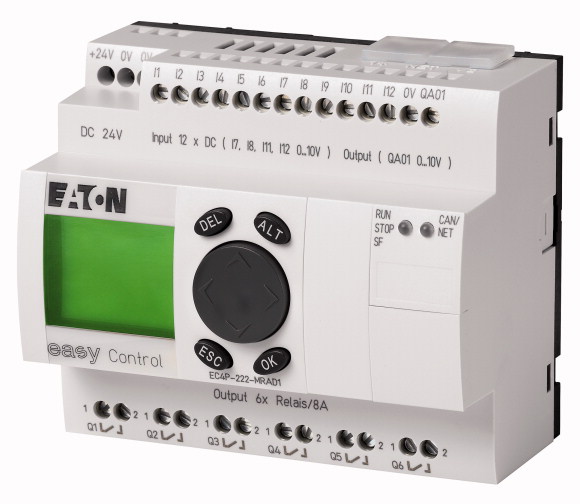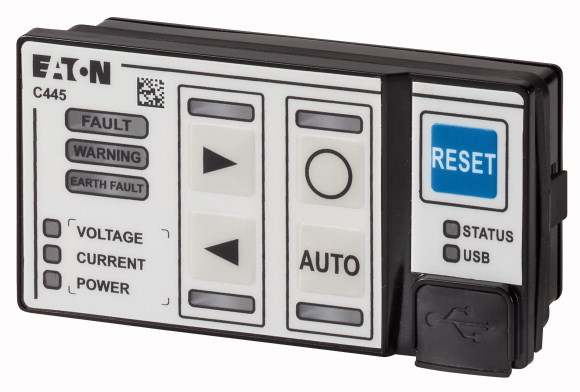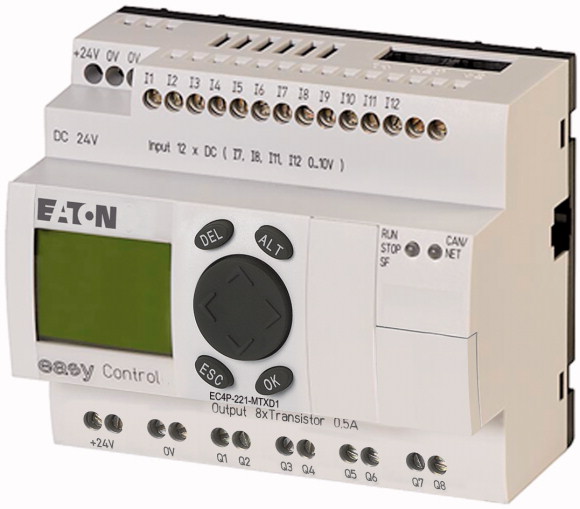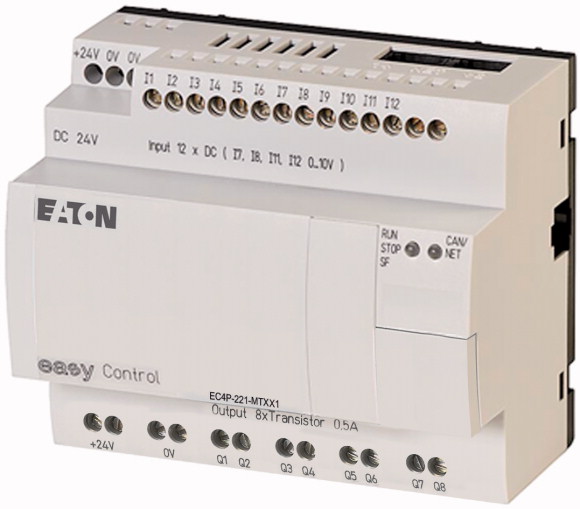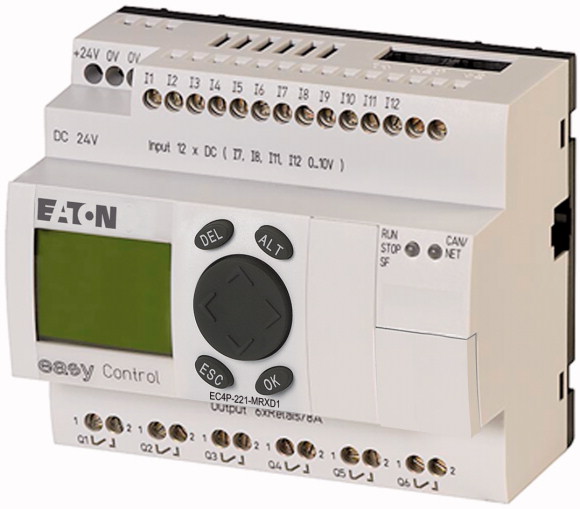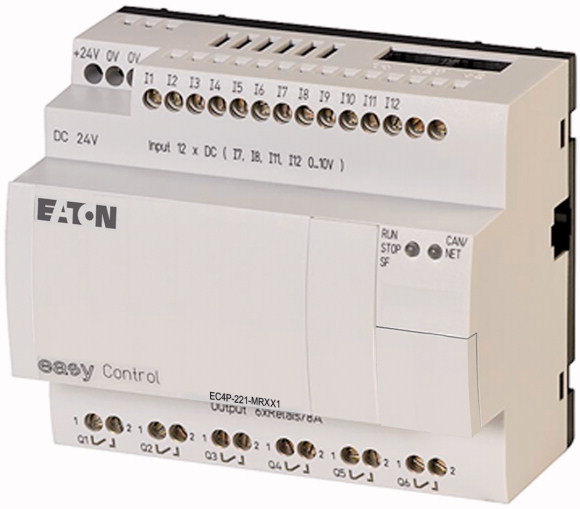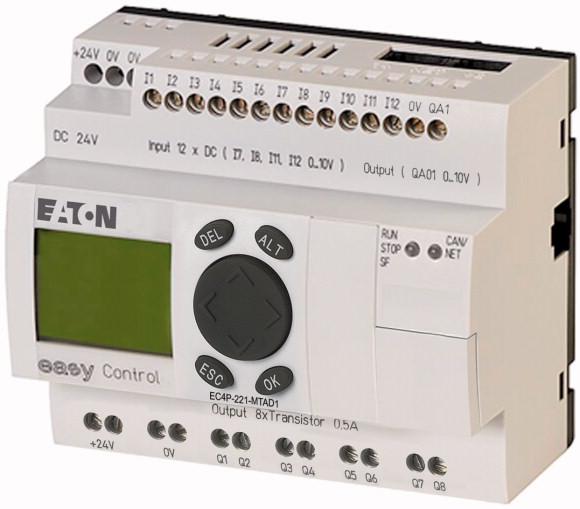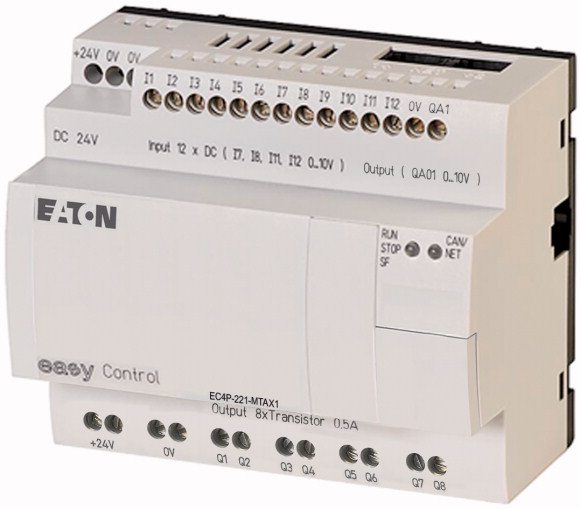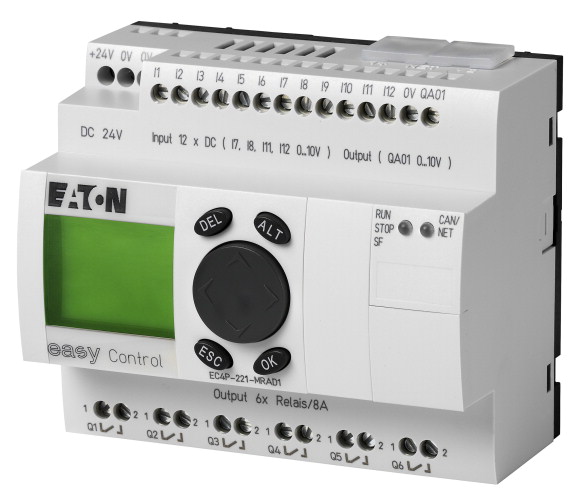| Description |
Expandable: Inputs/outputs and bus systems
individual laser inscription possible with EC4-COMBINATION-* |
| Digital |
easyNet/CANopen® and Ethernet on board |
| of which can be used as analog |
|
| Relay 10 A (UL) |
12 |
| Analog |
4 |
| Display & keypad |
|
| Supply voltage |
6 |
| Dimensions (W x H x D) |
1 |
| Weight |
|
| Mounting |
✓ |
| Solid |
24 V DC |
| Flexible with ferrule |
|
| Standard screwdriver |
107.5 x 90 x 72 without/79 with adapter for MCC (6 SU) mm |
| Max. tightening torque |
0.3 kg |
| Operating ambient temperature |
Top-hat rail IEC/EN 60715, 35 mm or screw fixing using 3 fixing brackets ZB4-101-GF1 (accessories) |
| Condensation |
|
| LCD display (clearly legible) |
0.2/4 (AWG 22 - 12) mm2 |
| Storage [ϑ] |
0.2/2.5 (AWG 22 - 12) mm2 |
| Relative humidity, non-condensing (IEC/EN 60068-2-30) |
0.8 x 3.5 mm |
| Air pressure (operation) |
0.6 Nm |
| Protection type (IEC/EN 60529, EN50178, VBG 4) |
|
Vibrations (IEC/EN 60068-2-6)
>Constant amplitude 0.15 mm |
-25 to 55, cold as per IEC 60068-2-1, heat as per IEC 60068-2-2 °C |
Vibrations (IEC/EN 60068-2-6)
>Constant acceleration 2 g |
Take appropriate measures to prevent condensation |
| Mechanical shock resistance (IEC/EN 60068-2-27) semi-sinusoidal 15 g/11 ms |
0 - 55 °C |
| Drop to IEC/EN 60068-2-31 [Drop height] |
-40 - +70 °C |
| Free fall, packaged (IEC/EN 60068-2-32) |
5 - 95 % |
| Mounting position |
1080 - 1080 hPa |
| Overvoltage category/pollution degree |
|
Electrostatic discharge (ESD)
>applied standard |
IP20 |
Electrostatic discharge (ESD)
>Air discharge |
10 - 57 Hz |
Electrostatic discharge (ESD)
>Contact discharge |
57 - 150 Hz |
| Electromagnetic fields (RFI) to IEC EN 61000-4-3 |
18 Impacts |
| Radio interference suppression |
50 mm |
| Burst |
1 m |
Burst
>Supply cable |
Vertical or horizontal |
Burst
>Signal lines |
|
| power pulses (Surge) |
II/2 |
| Immunity to line-conducted interference to (IEC/EN 61000-4-6) |
IEC EN 61000-4-2, Level 3 |
| Clearance in air and creepage distances |
8 kV |
| Insulation resistance |
6 kV |
| Back-up of real-time clock |
10 V/m |
| Accuracy of the real-time clock |
EN 55011 Class B, EN 55022 Class B |
| Write cycles of the retentive memory |
IEC/EN 61000-4-4, level 3 kV |
| Rated operational voltage [Ue] |
2 kV |
| Permissible range [Ue] |
2 kV |
| Residual ripple |
2 kV (supply cables, symmetrical, EASY...AC)
0.5 kV (supply cables, symmetrical, easy-DC)
according to IEC/EN 61000-4-5 |
| Input current |
10 V |
| Voltage dips |
|
| Heat dissipation [P] |
EN 50178, UL 508, CSA C22.2, No. 142 |
| Processor |
EN 50178 |
Memory
>Program code/data |
|
Memory
>Marker/retentive data |
 |
| Cycle time for 1 k of instructions (Bit, Byte) |
① Backup time (hours) with fully charged double layer capacitor
② Service life (years) |
PRG interface RS232
>Data transfer rate |
part no. ± 5 (± 0.5 h⁄Year) s/day |
PRG interface RS232
>Connection types |
|
PRG interface RS232
>Potential isolation |
10000000000 (10¹⁰) (Read-write cycles) |
PRG interface RS232
>Master mode
>Data transfer rate |
|
PRG interface RS232
>Master mode
>Character formats |
24 DC (-15/+20%) V |
PRG interface RS232
>Master mode
>Number of transmission bytes in a block |
20.4 - 28.8 V DC |
PRG interface RS232
>Master mode
>Number of received bytes in a block |
≦ 5 % |
Ethernet
>Data transfer rate |
normally 140 mA at Ue |
Ethernet
>Connection types |
≤ 10
(IEC/EN 61131-2) ms |
Ethernet
>Potential isolation |
Normally 3.4 W |
CANopen®
>Data transfer rate |
|
CANopen®
>Bus termination (first and last station) |
Infineon XC161 |
CANopen®
>Connection types |
256/14 segments of 16 KB each kByte |
Master mode
>Number |
16/4/4/8 KByte |
Mode slave
>Stations |
< 0.3 ms |
Mode slave
>PDO type |
|
Mode slave
>Control contact rated current |
4.8, 9.6, 19.2, 38.4, 57.6, 115.2 (character format: 8 bit data, no parity, 1 stop bit) kBit/s |
| Number |
RJ45-bus |
| Inputs can be used as analog inputs |
none |
| Status Display |
0.3, 0.6, 1.2, 2.4, 4.8, 9.6, 19.2, 38.4, 57.6 kbit/s |
| Potential isolation |
8E1, 8O1, 8N1, 8N2, 7E2, 7O2, 7N2, 7E1 |
| Rated operational voltage [Ue] |
190 bytes |
| Input voltage |
190 bytes |
Input current on 1 signal
>Input current at signal 1 |
10 MBit/s, 100 m Mbit/s |
| Deceleration time |
RJ45 |
| Cable length |
No |
Incremental counter
>Number of counter inputs |
500 kBit/s, 25 m
250 kBit/s, 60m
125 kBit/s, 125 m
50 kBit/s, 300 m
20 kBit/s, 700 m
10 kBit/s, 1000 m |
Incremental counter
>Value range |
EASY-NT-R plug (incl. bus terminating resistor 120 Ω) |
Incremental counter
>Counter frequency |
2 x RJ45, 8 pole |
Incremental counter
>Pulse shape |
8 |
Incremental counter
>Counter inputs |
max. 126 Number |
Incremental counter
>Reference input |
Asynchronous, cyclic, acyclic |
Incremental counter
>Input for reference switch |
To DS 301 V4 |
Incremental counter
>Counter inputs I1 and I2, I3 and I4 |
|
Incremental counter
>Signal offset |
12 |
Rapid counter inputs
>Number |
4 (I7, I8, I11, I12) |
Rapid counter inputs
>Value range |
LCD-Display |
Rapid counter inputs
>Cable length |
from the outputs: yes
to network easyNet, easyLink |
Rapid counter inputs
>Counter frequency |
24 V DC |
Rapid counter inputs
>Pulse shape |
< 5 (I1 - I6, I9 - I10) < 8 (I7, I8, I11, I12) at signal "0"
> 15.0 (I1 - I6, I9, I10) > 8.0 (I7, I8, I11, I12) at signal "1" V DC |
| Number |
3.3 (I1 to I6)
2.2 (I7, I8)
3.3 (I9, I10)
2.2 (I11, I12) mA |
| Potential isolation |
normally 0.02 (I1 - I4), normally 0.25 (I5 - I12) (from ´´0´´ to "1")
normally 0.02 (I1 - I4), normally 0.25 (I5 - I12) (from ´´0´´ to "1") ms |
| Input type |
100 (unshielded) m |
| Signal range |
1 (I1, I2, I3, I4) |
| Resolution |
32 Bit |
| Input impedance |
≦ 40 kHz |
Accuracy of actual value
>Within a single device |
Square |
| Conversion time, analog/digital |
I1, I2 |
| Input current |
I3 |
| Cable length |
I4 |
| Number |
1 |
| Output type |
90° |
| Max. output current |
2 (I1, I2) at 16 Bit or 1 (I1) at 32 Bit |
| Load resistance |
16/32 Bit |
| Overload and short-circuit protection |
≦ 20 (screened) m |
| Resolution |
≦ 50 kHz |
| Recovery time |
Square |
Accuracy
>-25 °C - 55 °C |
|
Accuracy
>25°C |
4 (I7, I8, I11, I12) |
| Conversion time, analog/digital |
from the outputs: yes
to interface/memory card: no |
| Outputs in groups of |
DC voltage |
| Parallel switching of outputs for increased output |
0-10 V DC |
| Protection of an output relay |
0.01 V analog
0.01 V digital
10 Bit (value 0 - 1023) |
| Potential isolation |
11.2 kΩ |
| Lifespan, mechanical [Operations] |
± 2, (I7, I8, I11, I12) ± 0.12 V % |
Contacts
>Conventional thermal current (10 A UL) |
each CPU cycle ms |
Contacts
>Recommended for load: 12 V AC/DC |
< 1 mA |
Contacts
>Short-circuit-proof cos ϕ = 1, characteristic B16 at 600 A |
≦ 30, screened m |
Contacts
>Short-circuit-proof cos ϕ = 0.5 to 0.7, characteristic B16 at 900 A |
|
Contacts
>Rated impulse withstand voltage Uimp of contact coil |
1 |
Contacts
>Rated operational voltage [Ue] |
DC voltage |
| Rated insulation voltage [Ui] |
0.01 A |
| Safe isolation according to EN 50178 |
1 kΩ |
Making capacity
>AC–-15, 250 V AC, 3 A (600 ops./h) [Operations] |
Yes |
Making capacity
>DC-13, L/R ≦ 150 ms, 24 V DC, 1 A (500 S/h) [Operations] |
0.01 V DC analog
10 Bit (value 0 - 1023) digital |
Breaking capacity
>AC-15, 250 V AC, 3 A (600 Ops./h) [Operations] |
100 µs |
Breaking capacity
>DC-13, L/R ≦ 150 ms, 24 V DC, 1 A (500 S/h) [Operations] |
2 % |
Filament bulb load
>1000 W at 230/240 V AC [Operations] |
1 % |
Filament bulb load
>500 W at 115/120 V AC [Operations] |
each CPU cycle ms |
Fluorescent lamp load
>Fluorescent lamp load 10 x 58 W at 230/240 V AC
>With upstream electrical device [Operations] |
|
Fluorescent lamp load
>Fluorescent lamp load 10 x 58 W at 230/240 V AC
>Uncompensated [Operations] |
1 |
Fluorescent lamp load
>Fluorescent lamp load 1 x 58 W at 230/240 V AC, conventional, compensated [Operations] |
Not permissible |
Switching frequency
>Mechanical operations |
Miniature circuit-breaker B16 or fuse 8 A (slow) |
Switching frequency
>Switching frequency |
from power supply: yes
From the inputs: yes
in groups
Safe isolation according to EN 50178: 300 V AC
Basic isolation: 600 V AC |
Switching frequency
>Resistive load/lamp load |
10 x 106 |
Switching frequency
>Inductive load |
8 A |
UL/CSA
>Uninterrupted current at 240 V AC |
> 500 mA |
UL/CSA
>Uninterrupted current at 24 V DC |
16 A |
UL/CSA
>AC
>Control Circuit Rating Codes (utilization category) |
16 A |
UL/CSA
>AC
>Max. rated operational voltage |
6 kV |
UL/CSA
>AC
>max. thermal continuous current cos ϕ = 1 at B 300 |
250 V AC |
UL/CSA
>AC
>max. make/break cos ϕ ≠ capacity 1 at B 300 |
250 V AC |
UL/CSA
>DC
>Control Circuit Rating Codes (utilization category) |
300 between coil and contact
300 between two contacts V AC |
UL/CSA
>DC
>Max. rated operational voltage |
300000 |
UL/CSA
>DC
>Max. thermal uninterrupted current at R 300 |
200000 |
UL/CSA
>DC
>Max. make/break capacity at R 300 |
300000 |
| Bus termination (first and last station) |
200000 |
| Rated operational current for specified heat dissipation [In] |
25000 |
| Heat dissipation per pole, current-dependent [Pvid] |
25000 |
| Equipment heat dissipation, current-dependent [Pvid] |
25000 |
| Static heat dissipation, non-current-dependent [Pvs] |
25000 |
| Heat dissipation capacity [Pdiss] |
25000 |
| Operating ambient temperature min. |
10 x 106 |
| Operating ambient temperature max. |
10 Hz |
10.2 Strength of materials and parts
>10.2.2 Corrosion resistance |
2 Hz |
10.2 Strength of materials and parts
>10.2.3.1 Verification of thermal stability of enclosures |
0.5 Hz |
10.2 Strength of materials and parts
>10.2.3.2 Verification of resistance of insulating materials to normal heat |
10 A |
10.2 Strength of materials and parts
>10.2.3.3 Verification of resistance of insulating materials to abnormal heat and fire due to internal electric effects |
8 A |
10.2 Strength of materials and parts
>10.2.4 Resistance to ultra-violet (UV) radiation |
B 300 Light Pilot Duty |
10.2 Strength of materials and parts
>10.2.5 Lifting |
300 V AC |
10.2 Strength of materials and parts
>10.2.6 Mechanical impact |
5 A |
10.2 Strength of materials and parts
>10.2.7 Inscriptions |
3600/360 VA |
| 10.3 Degree of protection of ASSEMBLIES |
R 300 Light Pilot Duty |
| 10.4 Clearances and creepage distances |
300 V DC |
| 10.5 Protection against electric shock |
1 A |
| 10.6 Incorporation of switching devices and components |
28/28 VA |
| 10.7 Internal electrical circuits and connections |
|
| 10.8 Connections for external conductors |
EASY-NT-R plug (incl. bus terminating resistor 120 Ω) |
10.9 Insulation properties
>10.9.2 Power-frequency electric strength |
|
10.9 Insulation properties
>10.9.3 Impulse withstand voltage |
0 A |
10.9 Insulation properties
>10.9.4 Testing of enclosures made of insulating material |
0 W |
| 10.10 Temperature rise |
0 W |
| 10.11 Short-circuit rating |
3.4 W |
| 10.12 Electromagnetic compatibility |
0 W |
| 10.13 Mechanical function |
-25 °C |
| Contains function building blocks |
+55 °C |
| Contains basic device |
|
| Contains module rack |
Meets the product standard´s requirements. |
| Contains power supply |
Meets the product standard´s requirements. |
| Contains analogue input module |
Meets the product standard´s requirements. |
| Contains analogue output module |
Meets the product standard´s requirements. |
| Contains digital input module |
Meets the product standard´s requirements. |
| Contains digital output module |
Does not apply, since the entire switchgear needs to be evaluated. |
| Contains function module |
Does not apply, since the entire switchgear needs to be evaluated. |
| Contains technology module |
Meets the product standard´s requirements. |
| Contains communication module |
Meets the product standard´s requirements. |
| Contains memory unit |
Meets the product standard´s requirements. |
| Contains simulation module |
Does not apply, since the entire switchgear needs to be evaluated. |
| Contains connection cable |
Does not apply, since the entire switchgear needs to be evaluated. |
| Contains control unit |
Is the panel builder´s responsibility. |
| Contains monitor |
Is the panel builder´s responsibility. |
| Contains programming software |
Is the panel builder´s responsibility. |
| Contains engineering software |
Is the panel builder´s responsibility. |
| Contains visualization |
Is the panel builder´s responsibility. |
| Contains libraries |
The panel builder is responsible for the temperature rise calculation. Eaton will provide heat dissipation data for the devices. |
| Contains documentation |
Is the panel builder´s responsibility. |
| Contains other components |
Is the panel builder´s responsibility. |
| Software preinstalled |
The device meets the requirements, provided the information in the instruction leaflet (IL) is observed. |
| Product Standards |
|
| UL File No. |
|
| UL Category Control No. |
Yes |
| CSA File No. |
Yes |
| CSA Class No. |
No |
| North America Certification |
Yes |
| Specially designed for North America |
Yes |
| Current Limiting Circuit-Breaker |
Yes |
| Degree of Protection |
Yes |

